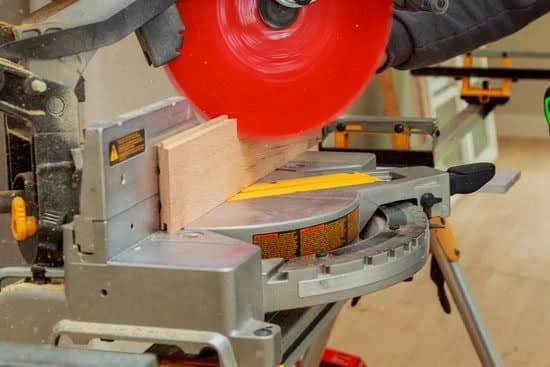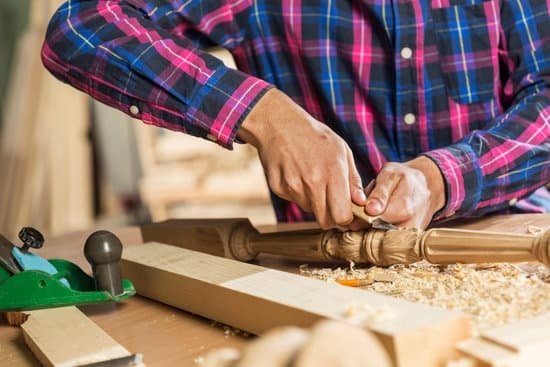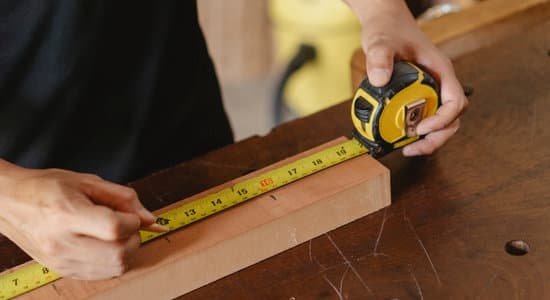Woodworking requires precision and accuracy to create beautiful, functional pieces. A crucial tool in achieving this precision is a protractor. Whether you are a beginner or an experienced woodworker, understanding how to use a protractor is essential for accurate angle measurements and cuts.
In this article, we will explore the importance of using a protractor in woodworking projects. We will discuss why it is crucial for achieving precise measurements and angles, as well as the different types and designs of protractors available.
Using a protractor allows woodworkers to accurately measure and set angles for various cuts and joinery techniques. It ensures that each piece fits together seamlessly, resulting in professional-looking craftsmanship. With the right protractor, you can easily achieve intricate designs and complex angle cuts.
By mastering the art of using a protractor in woodworking, you will enhance your skills and elevate the quality of your projects. So let’s dive into the world of protractors and discover how this tool can transform your woodworking experience.
Basic Overview of a Protractor
A protractor is a fundamental tool for woodworking that allows woodworkers to accurately measure and set angles in their projects. Understanding the components of a protractor is essential for using it effectively. In this section, we will provide a basic overview of a protractor and explain its different components.
The first component of a protractor is the graduated scale. This scale is typically marked in degrees and helps woodworkers measure angles with precision. The scale usually starts at 0 degrees and goes up to 180 degrees, making it suitable for measuring both acute and obtuse angles. Some protractors may have additional markings or scales for specific woodworking tasks, such as crown molding angles or slope measurements.
The rotating arm is another important component of a protractor. This arm can be moved along the graduated scale to measure an angle or set it for cutting purposes. The arm is usually connected to the main body of the protractor through a pivoting mechanism, allowing it to rotate freely.
To ensure accurate measurements, many protractors come with a locking mechanism. This mechanism allows woodworkers to lock the rotating arm in place once they have set the desired angle, preventing any accidental movement that could alter the measurement. It’s important to check that the locking mechanism on your protractor is in good working condition before use.
Inspecting and maintaining your protractor regularly is crucial to ensure optimal performance. Check that the graduated scale markings are clear and easily readable, as worn-out or faded markings can lead to inaccurate measurements. Keep your protractor clean from dirt or debris that could affect its functionality. If necessary, lubricate any moving parts with appropriate oils or greases to maintain smooth rotation.
Understanding these components of a protractor will allow you to work confidently and accurately when measuring angles in woodworking projects. In the next section, we will provide step-by-step instructions on how to use a protractor for measuring angles effectively. Stay tuned.
How to Use a Protractor for Measuring Angles in Woodworking
Step-by-Step Instructions for Measuring and Setting Angles
When it comes to woodworking, accurately measuring and setting angles is crucial for achieving precise cuts and joints. A protractor is an essential tool that allows woodworkers to measure and replicate angles with ease. In this section, we will provide step-by-step instructions on how to use a protractor for measuring angles in woodworking.
1. Prepare Your Protractor:
Before you begin measuring angles, ensure that your protractor is clean and free from any debris or dust. This will help you get accurate readings. It is also important to check that the rotating arm of your protractor moves smoothly without any stiffness or resistance.
2. Align the Protractor:
Place your protractor on the surface of the piece of wood where you want to measure the angle. Make sure that one side of the angle aligns with the centerline or baseline of the graduated scale on your protractor.
3. Read the Angle Measurement:
Look at where the other side of the angle intersects with the graduated scale on your protractor. Read and record this measurement.
4. Set Angles:
To set a specific angle on your protractor, loosen the locking mechanism if applicable, then rotate the rotating arm until it aligns with the desired measurement on the graduated scale. Finally, lock the mechanism to secure the position.
Tips for Avoiding Common Mistakes
- Ensure Stability: It’s essential to have stability when using a protractor for measurement. Securely clamp down your workpiece whenever possible to prevent movement while taking measurements.
- Use Light Pressure: When placing and aligning a protractor on a piece of wood, use gentle pressure so as not to damage or dent its surface.
- Double-Check Measurements: To ensure accuracy, it’s always helpful to double-check your measurements using multiple reference points or by using a combination square or other measuring tools.
- Practice Makes Perfect: Like any new skill, using a protractor to measure angles in woodworking takes practice. Don’t get discouraged if your first attempts are not perfect. Keep practicing and refining your technique.
By following these step-by-step instructions and implementing the tips mentioned, you will be able to effectively use a protractor for measuring angles in woodworking projects, resulting in accurate and precise cuts and joints.
Ensuring Precise Measurements
To ensure precise measurements when using a protractor, it’s important to pay attention to certain factors:
- Lighting: Ensure that there is adequate lighting on your work area so that you can clearly read the angle measurement on the graduated scale of the protractor.
- Alignments: Make sure that the edges or lines you are measuring align perfectly with the centerline or baseline of the graduated scale on the protractor.
- Parallax Effect: Avoid any parallax error by ensuring that your eye level is directly over the angle being measured. This will prevent misjudgment caused by looking at an angle from an incorrect perspective.
By considering these factors and practicing proper technique, you can achieve precise measurements using a protractor in your woodworking projects.
Understanding the Principles of Using a Protractor in Woodworking
The use of a protractor in woodworking is based on the principles of angular measurements. Understanding these principles is essential to achieving precise and accurate results in woodworking projects.
Angular measurements are used to determine the amount of rotation or angle between two lines or surfaces. In woodworking, this is crucial for creating joints, cutting angles for inclined surfaces, and achieving symmetry in design elements. By understanding the principles of using a protractor, woodworkers can enhance the quality and aesthetics of their woodwork.
To grasp the concept of angular measurements, it is important to familiarize oneself with key terms related to angles. The following terms are commonly used in woodworking:
- Degree: The unit of measurement for angles. A full circle contains 360 degrees.
- Vertex: The point where two lines or edges intersect, forming an angle.
- Arms: Refers to the two sides that form an angle.
When using a protractor, it is important to identify the vertex and align one arm along one line or edge while pivoting the protractor’s rotating arm until it intersects with the second line or edge. The scale on the protractor indicates the degree of rotation.
Understanding these principles will enable woodworkers to accurately measure and set angles when using a protractor. It is also important to take into account any specific instructions or guidelines provided by the woodworking plans or project requirements.
In summary, utilizing a protractor in woodworking relies on understanding angular measurements and applying them accurately in various woodworking tasks. By mastering these principles, woodworkers can achieve precision and consistency in their projects.
Advanced Techniques
Measuring and Cutting Compound Angles
Once you have mastered the basic use of a protractor for measuring and setting angles in woodworking, you can move on to more advanced techniques like cutting compound angles. Compound angles are often required for complex woodworking projects such as constructing furniture or building intricate joinery.
To measure and cut compound angles with precision, follow these steps:
- Determine the First Angle: Begin by using your protractor to measure the first angle needed for your compound cut. Place the base of the protractor against one edge of the wood and align the zero mark with that edge. Read the measurement from the graduated scale while ensuring that the rotating arm is aligned with the other edge of the wood.
- Set Up Your Saw: Once you have determined the first angle, set up your saw accordingly. Depending on your project, you may need to tilt both the blade and table of your saw to achieve the desired compound angle. Follow your saw’s manufacturer instructions for adjusting these settings.
- Measure and Mark Second Angle: Next, use your protractor to measure and mark the second angle required for your compound cut. Position the base of the protractor against one face of the wood perpendicular to your first cut line. Align one edge of the rotating arm parallel to that face and read off the desired angle from the graduated scale when it intersects with your second cut line.
- Make Your Cut: With both angles measured and marked, carefully position your wood on your saw bed according to those marks. Use clamps or other appropriate measures to securely hold it in place during cutting. Double-check that everything is properly aligned before making your compound cut with confidence.
Examples of Intricate Woodworking Projects
Using a protractor for complex angle cuts can elevate your woodworking projects to new levels of intricacy and craftsmanship. Here are some examples where a protractor is indispensable:
- Building a Staircase: Staircases often involve complex angles and compound cuts to ensure a precise fit. Using a protractor in this scenario can help you accurately measure and cut the stringers, balusters, and other components necessary for constructing a staircase that is both functional and aesthetically pleasing.
- Creating Compound Angled Joints: Certain joinery techniques, such as mitered dovetails or lock miter joints, require specific compound angles to achieve a tight and seamless connection. A protractor enables you to measure and cut these angles precisely, resulting in strong and visually appealing joints.
- Designing Intricate Furniture Pieces: When designing unique furniture pieces with intricate angles, such as chairs with curved backs or tables with angled legs, using a protractor is crucial for achieving the desired aesthetic. By accurately measuring and cutting compound angles, you can bring your furniture designs to life with precision and elegance.
By learning advanced techniques for using a protractor in woodworking projects, you can take your craftsmanship skills to new heights. Practice regularly and experiment with different angle cuts to expand your knowledge and capabilities as a woodworker. The possibilities are endless when you have mastered the art of using a protractor for complex angle cuts.
Alternative Methods
One of the key aspects of woodworking is accurately measuring and cutting angles. A protractor is an essential tool that many woodworkers rely on for this purpose. However, there are also other angle-measurement tools available, such as sliding bevels or digital angle finders. In this section, we will compare a protractor to these alternative methods and discuss when and why a protractor may be the preferred choice in woodworking.
Comparing Tools: Protractor vs. Sliding Bevels
| Protractor | Sliding Bevel |
|---|---|
| A protractor has a circular or semicircular shape with a graduated scale, rotating arm, and locking mechanism. | A sliding bevel consists of a handle connected to a metal blade that can be locked at any desired angle. |
| Protractors are especially useful for measuring and setting precise angles on curved surfaces. | Sliding bevels are great for transferring angles and creating lines at specific angles. |
| A protractor is generally more affordable and widely available compared to sliding bevels. | Sliding bevels tend to be more expensive but offer greater versatility in certain woodworking tasks. |
Digital Angle Finders: A Comparison
Another popular alternative to using a traditional protractor is a digital angle finder. These devices provide accurate measurements by utilizing electronic sensors.
| Protractor | Digital Angle Finder |
|---|---|
| A traditional protractor is a manual tool that requires visual alignment and reading of measurements on a scale. | A digital angle finder displays the precise angle measurement on a digital screen, eliminating the need for manual reading and interpretation. |
| Protractors offer sufficient accuracy for most woodworking projects when used correctly. | Digital angle finders provide high precision measurements within seconds. |
| Protractors are generally more cost-effective compared to digital angle finders. | Digital angle finders can be expensive, especially higher-end models with advanced features. |
While sliding bevels and digital angle finders have their advantages, a protractor remains a popular choice among woodworkers due to its affordability, accessibility, and versatility. Protractors can handle various woodworking tasks with ease, including measuring angles on curved surfaces and transferring angles accurately. However, if higher precision or advanced features are required, considering alternative methods such as sliding bevels or digital angle finders may be beneficial.
Tips and Tricks for Maximizing Accuracy with a Protractor in Woodworking
When it comes to using a protractor in woodworking, precision is key. To ensure accurate measurements and angles in your projects, here are some essential tips and tricks:
- Secure the Protractor: Before using the protractor, make sure it is securely placed on the surface of your wood material. Use clamps or hold it firmly against a straight edge to prevent any movement or slippage during measurement.
- Level the Surface: It is important to have a level surface when using a protractor. Uneven surfaces can affect the accuracy of your measurements. Use shims or sandpaper to level out any irregularities before placing the protractor.
- Read from Eye Level: Position yourself at eye level with the protractor’s markings when reading angle measurements. This will minimize parallax error and give you a more accurate reading.
- Be Mindful of Contact Points: When measuring angles, pay attention to where the rotating arm of the protractor contacts with your wood material. Ensure that it makes consistent contact along its length to avoid skewed measurements.
- Avoid Interference: If you are working with large pieces of wood or intricate cuts, there may be obstructions that prevent you from directly placing the flat side of the protractor on the surface. In such cases, use auxiliary blocks or spacers to create a flat reference surface for accurate angle measurement.
- Double-check Measurements: Always double-check your angle measurements before making any cuts or joining pieces together. Small errors in setting an angle can lead to significant problems later on in your project. Taking an extra moment to verify your measurements can save time and materials in the long run.
By incorporating these tips and tricks into your woodworking routine, you can ensure the utmost accuracy when using a protractor for measuring angles. Remember, practice makes perfect, so don’t be discouraged if it takes some time to master these techniques. With patience and experience, you will enhance your woodworking skills and achieve impeccable craftsmanship.
Frequently Asked Questions about Using a Protractor for Woodworking
As you delve into the world of woodworking and explore the use of a protractor, you may have some questions along the way. In this section, we will address some of the most common queries from beginners and experienced woodworkers alike to help you gain a better understanding of using a protractor effectively in your woodworking projects.
- Q: How do I choose the right protractor for my woodworking needs?
- A: When selecting a protractor, it’s important to consider the type and design that would work best for your specific woodworking tasks. There are different types of protractors available, such as 180-degree or 360-degree variants, as well as specialized ones like miter protractors. Choose one that offers clear markings and is easy to read. Additionally, consider the size and material of the protractor, ensuring it is suitable for your woodworking environment.
- Q: Can I use any protractor for measuring compound angles?
- A: While a basic protractor can be used for measuring simple angles, measuring compound angles requires more advanced techniques. If you frequently work with complex angle cuts in your woodworking projects, it may be worth investing in a specialized tool like an adjustable bevel or a digital angle finder. These tools can provide more accurate measurements and greater flexibility when working with compound angles.
- Q: How do I ensure precise measurements when using a protractor?
- A: Achieving accurate measurements with a protractor requires proper technique and attention to detail. Always ensure that the base of the protractor is firmly against the reference surface before taking measurements. Use a sharp pencil or marking knife to make precise marks on your wood pieces. Additionally, double-check your measurements by comparing them with other reference points or by rechecking them using different methods if possible.
By addressing these frequently asked questions, we hope to provide clarity and confidence in using a protractor for woodworking. Remember, practice and experimentation will help you develop your skills and craftsmanship.
Conclusion
In conclusion, using a protractor is an essential skill for any woodworker looking to achieve precision and accuracy in their projects. Throughout this article, we have explored the importance of a protractor in woodworking and provided detailed insight into its components, usage, and advanced techniques. By understanding the principles of angular measurements and practicing with a protractor, woodworkers can enhance the quality and aesthetics of their woodwork.
One key takeaway from this article is the step-by-step instructions on how to measure and set angles accurately using a protractor. By following these instructions and avoiding common mistakes, woodworkers can ensure precise measurements and avoid any potential errors that may arise during their projects. The use of a protractor also allows for more intricate angle cuts, particularly for compound angles, making it an indispensable tool in advanced woodworking projects.
It is crucial to note that while there are alternative angle-measurement tools available such as sliding bevels or digital angle finders, the protractor remains a preferred choice for many woodworkers due to its versatility and ease of use. The ability to inspect and maintain your protractor properly will also contribute to optimal performance throughout your woodworking journey.
Frequently Asked Questions
How do you use a wood protractor?
To use a wood protractor, start by aligning the center point of the protractor with the vertex (the point where the two lines of the angle meet) of the angle you want to measure. Then, make sure that one of the lines on your angle aligns with the 0-degree line on the protractor.
Next, read and note down the measurement where your other line intersects with one of the degree markings on the curved part of the protractor. This will give you an accurate measurement of your angle in degrees.
How do you use a contractor protractor?
A contractor protractor, also known as a construction protractor or an adjustable protractor, is used similarly to a wood protractor but offers more flexibility in measuring angles. To use a contractor protractor, place it on your work surface and adjust it to match one of the lines on your angle by sliding its movable arm back and forth.
Ensure that both arms are touching each line of your angle while keeping them locked in position using any locking mechanism present. Finally, read and record the measurement indicated on either side to determine the angle’s value in degrees.
How do you measure angles in carpentry?
Measuring angles in carpentry requires some basic tools such as a combination square, bevel gauge, or even a speed square with an angle guide. There are multiple approaches depending on whether you need to measure an existing angle or transfer an angle from one piece to another.
When measuring an existing angle, hold your tool against one side of the corner and match it with another side until you find an accurate fit; then note down or transfer that measurement onto your workpiece for reference when cutting or marking angles accordingly.

Hi everyone! I’m a woodworker and blogger, and this is my woodworking blog. In my blog, I share tips and tricks for woodworkers of all skill levels, as well as project ideas that you can try yourself.





